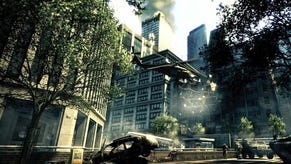Crysis 2 tech demo analysed
The challenge of "nothing under 30FPS".
Can consoles run Crysis? That was the question Digital Foundry posed in December last year, pulling apart CryTek's own engine demos and pitting their in-house work against the shipping PC title.
The result was inconclusive, but one thing was apparent: maintaining frame-rate was problematic in the demos, and we foresaw a serious retooling of the Crysis concept in order to more adequately accommodate the limitations of console technology.
CryTek's recent reveal of the in-progress Crysis 2 at a press event in New York impressed all that saw it. The developer chose to showcase the game on Xbox 360 in an attempt to shake off the lingering doubts that CryEngine tech can transition across to the consoles, while at the same time demonstrating that the lush tropical environs of the original Crysis have been replaced with a more urban jungle, in line with our thoughts that a sequel would need to be tailored towards a setting more favourable to rendering on the likes of 360 and PS3.
Performance-wise, CryTek is bullish about the game's prospects.
"We're looking at 30 [frames per second]," CryTek CEO Cevat Yerli told VG247. "There's nothing below, nothing... I'm very happy the game works at all. I think the amount of push we have and the fact the game works like that puts me in a very happy situation right now."
CryEngine 3 is an immensely advanced piece of tech, and hitting that performance level is key. The New York press event was accompanied by the release of two videos: the first appears to be rendered out from the PC version, while the second is the third in a series of CryEngine 3 tech demos.
This latter video, created for GDC 2010 (and so we can assume a few weeks older than the Xbox 360 version taken to NYC) gives us some idea of how performance is looking in the scenes taken from Crysis 2.
Similar to the previous CE3 tech demos, there are some performance issues. Some of this is down to the fact that for this video at least, CryTek chose to enable v-sync, and the double-buffer nature of the renderer means that any frame-drops result in a big performance drop down to 20FPS almost by default.
We can expect the final game to operate far more smoothly than what is shown here, but it's clear that the challenge facing the developer in reaching Cevat Yerli's "nothing below 30FPS" target is significant.
On the computer side of things, console-level optimisations in terms of memory and of course multi-core processing roll back very nicely into the PC side of the equation. Combine the new tech seen in CE3 with the all goodies of CE2 and it should be something really special.
Crysis 2 at E3: we're so there.









